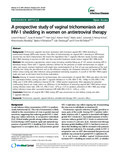A prospective study of vaginal trichomoniasis and HIV-1 shedding in women on antiretroviral therapy

View/
Date
2011-11-03Author
Masese, Linnet N
Graham, Susan M
Gitau, Ruth
Peshu, Nobert
Jaoko, Walter
Ndinya-Achola, JO
Mandaliya, Kishorchandra
Richardson, Barbra A
Overbaugh, Julie
McClelland, R S
Type
Journal ArticleMetadata
Show full item recordAbstract
Background
Trichomonas vaginalis has been associated with increased vaginal HIV-1 RNA shedding in antiretroviral therapy (ART)-naïve women. The effect of trichomoniasis on vaginal HIV-1 shedding in ART-treated women has not been characterized. We tested the hypothesis that T. vaginalis infection would increase vaginal HIV-1 RNA shedding in women on ART, and that successful treatment would reduce vaginal HIV-1 RNA levels.
Methods
We conducted a prospective cohort study including monthly follow-up of 147 women receiving ART in Mombasa, Kenya. Those with T. vaginalis infection, defined by the presence of motile trichomonads on vaginal saline wet mount, received treatment with single dose metronidazole (2 g). Test of cure was performed at the next monthly visit. Using the pre-infection visit as the reference category, we compared detection of vaginal HIV-1 RNA before versus during and after infection using generalized estimating equations. A cut-off of 100 HIV-1 RNA copies/swab was used as the lower limit for linear quantitation.
Results
Among 31 women treated for trichomoniasis, the concentration of vaginal HIV-1 RNA was above the limit for quantitation before, during, and after T. vaginalis infection in 4 (13% [95% CI 4% - 30%]), 4 (13% [95% CI 4% - 30%]), and 5 (16% [95% confidence interval {CI} 5% - 34%]) women respectively. After adjusting for potential confounding factors, we could detect no difference in the likelihood of detecting vaginal HIV-1 RNA before versus during infection (odds ratio [OR] 1.41, 95% CI 0.23 - 8.79, p = 0.7). In addition, detection of HIV-1 RNA was similar before infection versus after successful treatment (OR 0.68, 95% CI (0.13 - 3.45), p = 0.6).
Conclusion
Detection of vaginal HIV-1 RNA during ART was uncommon at visits before, during and after T. vaginalis infection.
URI
http://dx.doi.org/10.1186/1471-2334-11-307http://erepository.uonbi.ac.ke:8080/xmlui/handle/123456789/14697
http://www.ncbi.nlm.nih.gov/pubmed/22047086
